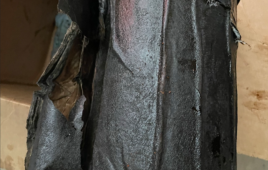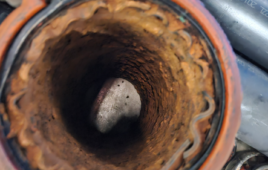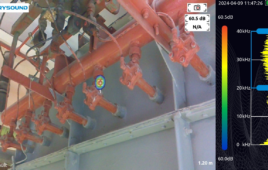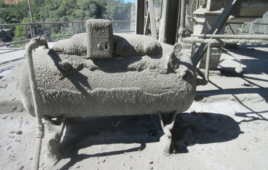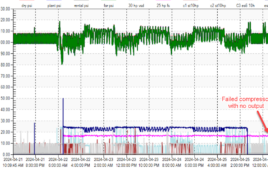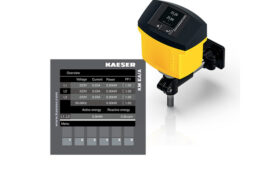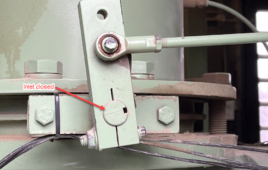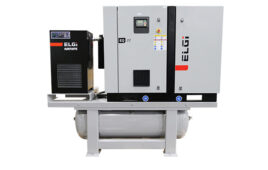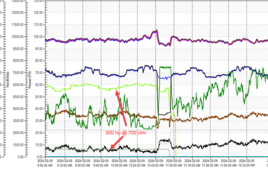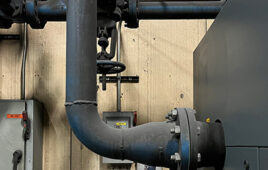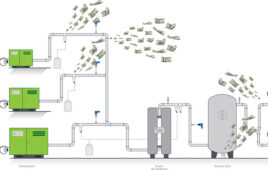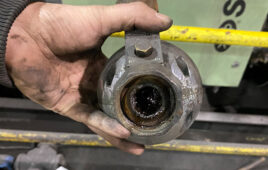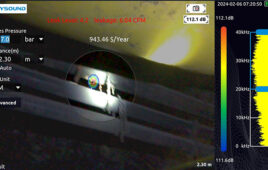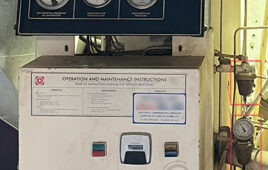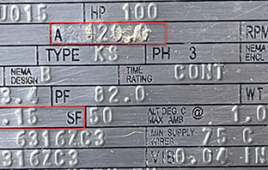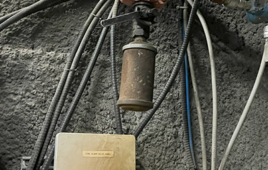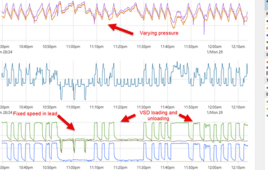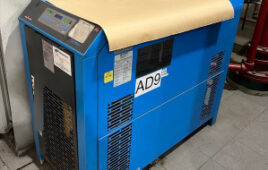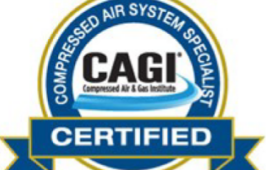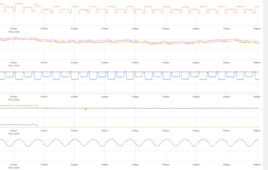Did you know that garbage bags have a use in the compressed air industry? The use of garbage bags to determine compressed air leakage, is described in the U.S. Department of Energy’s (USDOE) MEASUR tool and is a straightforward and cost-effective method for roughly estimating air leaks in a compressed air system. This technique is […]
Compressed air fail: Pipe and tank corrosion
Corrosion in steel pipes and storage receivers within compressed air systems is a common issue that can significantly impact system efficiency, safety, and longevity. This process is primarily driven by the presence of water and acid condensate, both of which are common byproducts in compressed air environments. Understanding how corrosion occurs can help in implementing […]
Compressed air fail: Dust collectors
Dust collector reverse pulse cleaning is commonly deployed in any industry that creates powdered dust. Through the years, it is common to see expensive failures of these devices that consume excessive amounts of compressed air. Often times, these failures go undetected. Dust collector reverse pulse cleaning is a highly efficient method for removing accumulated dust […]
Compressed air fair: Keep it cool, not cooked
Air-cooled air compressors are crucial to keeping the production process running in many industries; they work by turning power into usable energy. Their performance, however, depends heavily on their ability to stay cool. If dust and debris clog up a compressor, it can overheat, work less efficiently, and cost more to operate. Fig. 1 and […]
Compressed air fail: Happy ending
Tom, a diligent plant engineer at a mid-sized manufacturing facility, faced persistent problems with his compressed air system powering his crucial production lines. Despite repeated attempts to fix various symptoms — frequent drops in pressure, excessive energy consumption, and sporadic equipment failures — the problems persisted, causing costly downtime and frustration on the factory floor. […]
Compressed air fail: Bad KPIs
Compressed air systems classed as “best practices” have permanent monitoring systems installed that can automatically track the performance of the system. In this way, problems can be easily detected and dealt with quickly. Important variables like pressure, power, flow, temperature, and dew point are measured and sent to a central database, to be stored for […]
Compressed air fail: Apparent capacity increase
A plastic products producer was expanding its business and installed a few new machines. There already were five small compressors installed to feed the production machinery and the maintenance personnel were experiencing low pressure occurrences. These events would pull plant pressure down and cause product rejects and production shutdowns. The plant manager concluded that the […]
Kaeser Measurement Technology enhances compressed air system management
System efficiency is crucial in modern compressed air designs, which is why many compressed air management companies are developing tools to provide more insight into system operation. Smart technologies are in abundance in this regard, allowing factories and plants to capitalize on IoT data. To this end, Kaeser Compressors recently launched the new Kaeser Measurement […]
Compressed air fail: Poor man’s ducting
From time to time, compressed air auditors find air-cooled air compressors located in small rooms where the ventilation is inadequate. Most of the time, in properly designed rooms, the heat the compressors produce is ducted out of the room through metals ducting — often, it will be directed to cool areas of the plant in […]
Compressed air fail: Inlet valve problems
A mining complex was experiencing low pressure events — even though its 14 large compressors were all running. The pressure was adequate during most of the day, but during peak demand times, the pressure sagged to unacceptable levels. This, of course, caused complaints from the workers. The pressure settings of the compressors were already set […]
Oil-lubricated, direct-drive compressors for small- to medium-size operations
ELGi Compressors USA has introduced the EQ Series, a new range of oil-lubricated, direct drive rotary screw air compressors, designed to provide superior performance and reliability to small and medium-sized operations that traditionally use belt-driven air compressors. In line with ELGi’s customer-centric approach, the EQ ‘ELGi Quest’ Series is built for customers requiring reliable compressed […]
Cloud-based data prevents compressed air system downtime
Industry 4.0 aims to increase efficiency, productivity, quality, and sustainability while optimizing supply chains and workforces. It sounds like a tall order, but as more manufacturers adopt the Industrial Internet of Things (IIoT), edge devices, and cloud-based technologies, the more such efforts are realized. Of course, one of the fundamental challenges is extracting and leveraging […]
Compressed air fail: Capacity surprise
When doing a compressed air audit, it is always recommended to measure the important parameters of the system and analyze the data carefully. Typically, pressure and power (or amps) are monitored, but in some cases measurement of flow comes in handy. In the case of a large plumbing component manufacturer, the installation of flow meters […]
Compressed air fail: Outlet pipe size
A compressed air auditor was assessing a compressor and dryer installation within a compressor room and noticed something strange. On a large air dryer, the outlet flange was of 6-in. size, yet the piping used to connect the compressors and filters to the air dryer was only 4-in. Further to this, the long piping link […]
Creating a compressed air leak management plan
Measuring and repairing compressed air leaks can easily reduce energy costs by 10 to 20%. Compressed air is used in factories all over the world to control machines, processes, and pneumatic equipment. It is a safe and easily available medium and can be used in all possible places via hoses and pipes. However, compressed air […]
Compressed air fail: Crud in the lines
A compressed air auditor had a system of measuring devices that was monitoring a compressed air system located in a metal foundry. Pressure, flow, and compressor power were all monitored to help determine if the system was running efficiently and effectively. An additional set of instruments were added to the monitoring suite due to some […]
Compressed air fail: Drive by shooting
A compressed air auditor visited a large mine and was asked to look for areas of improvement. The mine’s manager was interested in reducing the electrical consumption and had a hunch that the compressed air system was a good item to investigate. The facility was a very mature site, so there were many large compressors […]
Compressed air fail: Obsolete compressor controls
Recently, a compressed air auditor ran across a newly rebuilt compressor at a wood products company. The unit was cleaned up nicely and had a shiny new air end due to a rebuild — but because the unit had obsolete controls, this compressor continued to run very inefficiently. Saving money by rebuilding this compressor was […]
Compressed air fail: Service factor
Quite often, people are surprised when they measure an air compressor and find the motor is consuming more than rated amps. One of the unfortunate things about the industry is that it is common to see motors are being stretched into the “service factor” in order to get more cfm out of a given compressor […]
Compressed air fail: Artificial demand
One hidden problem in many compressed air systems is something called “artificial demand.” Many users are unaware of the effects of this component of compressed air demand as evidenced by higher than needed compressed air pressures on most systems. Artificial demand in a compressed air system refers to the excess consumption of compressed air caused […]
Compressed air fail: Expensive air conditioning
Compressed air is useful for very many important tasks in facilities. However, due to the high cost of producing it, there are some end uses that are very wasteful. Air conditioning and ventilation is one such inappropriate end use. In a recent survey, a compressed air auditor found a surprisingly unique waste of compressed air […]
Compressed air fail: Corrupted VSD settings
When the equipment is new and set up correctly, the coordination of VSD air compressors with fixed speed units is quite easy — if the number of compressors in the mix is four or less. Typically, what should happen is the VSD compressor maintains trim position with all combinations of fixed speed compressors providing base […]
Compressed air fail: Hidden filter
A compressed air audit at a metal parts painting plant yielded some puzzling results. Pressure loggers were placed at the compressor discharge and in the plant, but the readings were showing an unexpected and significant pressure drop between the instruments. Visual checks showed that the only thing between the loggers was an air dryer with […]
How do you become a CAGI Certified CCASS?
By Ron Marshall You may have noticed some email signatures displaying the Certified CCASS symbol — and have become curious as to how that’s earned. Anyone, if properly prepared, can become certified by writing and passing an exam. The ease in preparing for the CAGI (Compressed Air and Gas Institute) Certified Compressed Air System Specialist […]
Compressed air fail: Dryer balance
A compressed air auditor was monitoring a system in a plant that produces plastic film. Part of the measurement involved analyzing the flow from the compressor room and the dewpoint of the compressed air. When examining the data, a strange pattern developed on the flow and dewpoint profiles (Fig. 1). We can see the output […]
